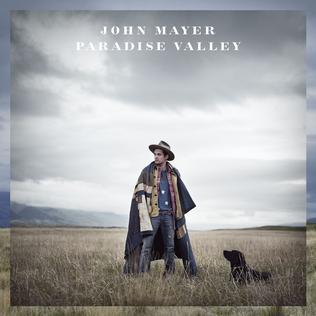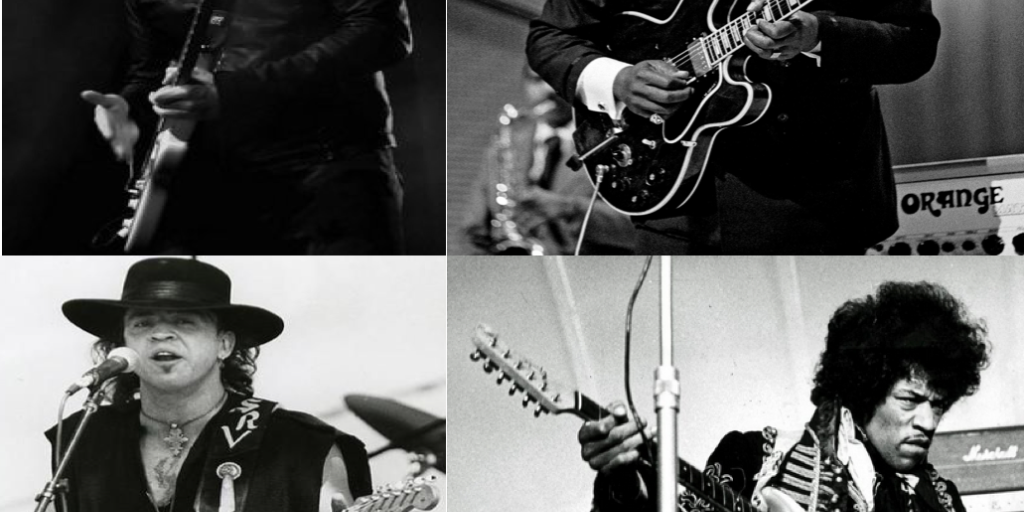
You may know John Mayer for some of his 7 Grammy Award winning (and 19 Grammy nominated) pop and rock music, but did you know that he is one of the most versatile and influential guitarists performing today?
In this series of articles, we will explore John Mayer’s music and playing style. One of the best ways to improve your own playing is to find someone to model your style after. Through studying his or her tone, technique, songs, and gear, you will find that your own playing will improve exponentially faster compared to if you were just learning songs from a bunch of random artists. Personally, John Mayer has been a huge influence on my own guitar playing, and I feel many people can benefit quite a bit from learning his playing style as it has a great blend of contemporary pop and traditional blues.
This series will explore key components of Mayer’s sound which includes his gear, his playing technique, and his songs. For this introductory article however, we will take a look at John Mayer’s career and his influence on modern pop music.
Who is John Mayer?
John Mayer is a multi-platinum and multi-Grammy award-winning American singer-songwriter, guitarist, and record producer. He was born in 1977 in Bridgeport, Connecticut and was first inspired to play the guitar when he saw Michael J. Fox (as Marty McFly in Back To The Future) perform Chuck Berry’s song “Johnny B. Goode.” He began playing guitar at 13. Eventually, he was introduced to the music of Stevie Ray Vaughan through a cassette that was given to him by a neighbor. From then on, Mayer became obsessed with the music of Stevie Ray Vaughan, and a large part of his blues guitar playing can be attributed to Vaughan. After two years of lessons and practice, Mayer began performing at local bars and clubs while he was still in high school. It was during this period where he began developing as a stage performer.
Upon graduating high school, Mayer enrolled into the prestigious Berklee College of Music where he further worked on his craft as a guitarist under Tomo Fujita. During this time, he also developed his unique songwriting style by picking up tips and tricks from professors like Pat Pattison. However, after two semesters at Berklee, Mayer dropped out of school and moved to Atlanta with his college friend, Clay Cook.
The duo formed a band called LoFi Masters and began playing in clubs, bars, and coffee houses around Atlanta. However, the two eventually fell out due to musical differences, and Mayer went on to record his first independent EP titled “Inside Wants Out” with a local producer and engineer. The EP had eight songs on it, and many of the songs eventually made it to Mayer’s first full-length major label release, Room For Squares.

Room For Squares was released in 2001 under Columbia Records and included several hits such as “Your Body Is A Wonderland,” and “No Such Thing.” His performance on “Your Body Is A Wonderland” won him his first Grammy for Best Male Pop Vocal Performance.
While Room For Squares is mainly a pop album, a lot of John Mayer’s understanding of jazz harmony that he picked up from Berklee can be heard in songs like “St. Patrick’s Day.” His virtuosic fingerstyle guitar playing was also demonstrated on “Neon,” and a lot of his blues lead guitar influences can be heard in many of the guitar solos throughout the album. At this point however, not many people quite knew the extent of Mayer’s guitar abilities--since he was viewed as mainly a pop star.
The year 2003 saw two releases by Mayer. The first was a live DVD and CD titled Any Given Thursday. It was recorded during a concert in Birmingham, Alabama and featured a few songs that didn’t make it on the Room For Squares album. These previously unreleased songs included numbers like “Man On The Side,” “Something’s Missing,” and “Covered In Rain.” This live album also started to expose Mayer’s abilities as a guitarist through performances like his cover of Stevie Ray Vaughan’s “Lenny.” During this period, many critics were quick to point out the contrast between his image as a teen pop-idol and his rise as this generation’s guitar hero. These are two seemingly contradictory ideas as most of the previous guitar heros that came before him were all part of the Rock ‘n’ Roll movement, so it caused some internal confusion and conflicts amongst his critics.
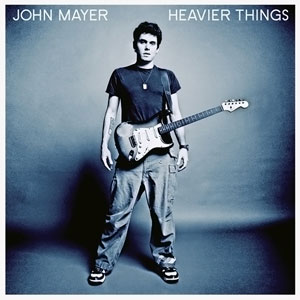
The second release in 2003 was an album titled Heavier Things, and it featured the Grammy Song Of The Year and Best Male Pop Vocal Performance winner, “Daughters.” Like his first album Room For Squares, Heavier Things was a huge commercial success. The album featured 10 electric-guitar driven pop songs, and like his previous full-length album, a lot of Mayer’s highly skilled lead guitar playing can be heard throughout the songs. One of my favorite John Mayer guitar solos can be heard in the closing track “Wheel.” It’s as if the solo was hinting at the things to come on the future albums as it featured several iconic aspects of Mayer’s electric guitar playing. It had his signature warm, slightly overdriven tone, his smooth, behind-the-beat slide technique, and his Jimi Hendrix-esque double stop technique.
Before releasing another full-length album, Mayer released another album of live recordings from seven nights of his 2004 U.S. tour. The album, titled As/Is featured songs from his two full-length albums and a cover of Marvin Gaye’s "Inner City Blues (Make Me Wanna Holler)."
Rise of a Bluesman
As I mentioned previously, John Mayer’s abilities as a guitarist, and specifically as a blues guitarist, had been noticed by music critics. While he had only released pop albums up to this point, he’d already been known to use his rising fame to score collaborations with legendary guitar players like B.B. King, Eric Clapton, and John Scofield. The general public may not have realized it yet, but people who were paying attention to Mayer’s work were slowly beginning to realize that John Mayer, at his core, was and is a high-level blues musician.
After his 2004 tour, Mayer announced that he was taking a break from his acoustic pop persona and would instead pursue other musical goals. In 2005, he formed a band with acclaimed session musicians Pino Palladino (The Who, D’angelo) and Steve Jordan (Saturday Night Live) and they called themselves the John Mayer Trio. Together, they played loud, unapologetic blues rock music, and they subsequently released a live album titled TRY! in November 2005. The collaboration between the three would eventually play a huge part in the production of Mayer’s following album -- Continuum.
While Room For Squares and Heavier Things did extremely well in the Billboard charts, neither of them would currently be considered career defining albums. That’s saying a lot considering both albums have Grammy awards attached to them. However, ask any John Mayer fan what they consider to be their favorite album and I can guarantee that almost all of them will name Continuum as their favorite. The thing that really set Continuum apart from Mayer’s previous albums was the inclusion of his Blues influences in the song writing. While previous albums were straight pop albums, Mayer had found a way to finally blend his main musical influence with his pop sensibilities in Continuum. The result was a sound that was completely new to listeners, all while maintaining the things that made John Mayer a huge star in the first place, mainly the great songwriting and catchy melodies.
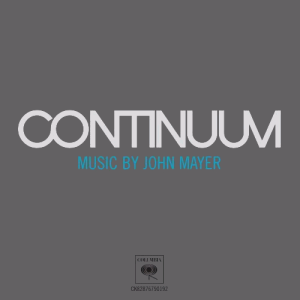
Continuum was released in September 2006, and it was produced by Mayer and Steve Jordan. By December, the album was nominated for five Grammy awards, including Album Of The Year. Mayer’s album with the trio, TRY!, also received a nomination for Best Rock Album. Eventually, Continuum won Best Pop Vocal Album and the songs “Waiting On The World To Change” and “Gravity” won the Best Male Pop Vocal Performance and Best Solo Rock Vocal Performance. Besides being nominated and winning a few Grammy awards, Mayer was also starting to receive widespread recognition for his guitar playing on Continuum. In his feature in the Rolling Stone (issue #1020), Mayer was dubbed as one of the “New Guitar Gods,” and he was also given the nickname “Slow Hand, Jr.,” in reference to Eric Clapton.
After the release of Continuum, Mayer released another live DVD and CD in 2008 titled Where The Light Is. The concert featured three different musical personas -- the solo acoustic act, the blues rock trio, and the pop-rock band. Mayer continues to carry out his live shows with these three acts to this day, which honestly is a treat for us fans. It’s like going to three different concerts in one night.
Battle Studies
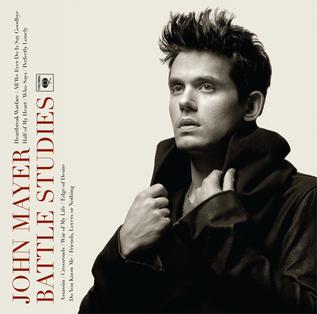
Following the huge success of Continuum, Mayer released another studio album in 2009 titled Battle Studies. Like his previous records, the album was a commercial success, debuting at number one on the Billboard Top 200 album charts. However, critical reviews were rather mixed with some reviewers calling it his most adventurous album, while others felt that he was playing it safe due to the fact that it was following the overwhelming success of Continuum. Mayer himself has even admitted before that writing a new album after the success of Continuum was a little intimidating. Regardless, the album still received a Grammy nomination for Best Pop Vocal Album, and the songs “Half of My Heart” and “Crossroads” were nominated for Best Male Pop Vocal Performance and Best Solo Rock Vocal Performance.
Learn with LPM
If you are looking to feel comfortable with playing basic major and minor chords, power chords, and apply different strumming techniques to your practices with Ze, check out his course called Rhythm Guitar
Health Problems and Return
Some time in 2011, Mayer started suffering from vocal problems while on tour for Battle Studies. This caused a delay in the release of his following studio album as it meant Mayer had to undergo vocal rest for at least a month, or so he thought. When vocal rest didn’t work, he underwent two surgeries that attempted to remove the granuloma in his vocal chords. This caused a further delay as it meant that Mayer had to take a few additional months of vocal rest. During this time, Mayer withdrew from the public eye, also in part due to his highly controversial 2010 interviews with Playboy and Rolling Stone, where he made some remarks that were widely considered racially insensitive.
When he finally reemerged fully healed in 2012, he finished up recording the final vocal tracks for his latest album and released it with the title Born And Raised. It debuted at number one on the Billboard Top 200 charts and received positive reviews from critics. Mayer himself declared the album to be his most intimate album yet, and this is demonstrated by the themes of loneliness, self-searching, and alcohol dependency throughout the album. Like the previous albums, Born And Raised featured Mayer’s iconic style of guitar playing throughout the album.
While planning a new tour for the release of his latest album, the granuloma unfortunately returned and this forced Mayer to take a break from singing indefinitely. This time it seemed a little more serious than the previous episode, and it actually had Mayer contemplating never singing again. He began exploring his options as a session guitarist and found himself backing artists like Frank Ocean and the Rolling Stones. During this time, he sought out additional medical treatment that forced him to be on vocal rest for several months.
In April 2013, after more than six months of vocal rest, Mayer made his return at a concert in the Tuscaloosa Amphitheater in Alabama. A few months later, he announced that he was about to finish up his sixth studio album titled Paradise Valley. This album saw collaborations with Frank Ocean and Katy Perry, and the album debuted at number two on the Billboard Top 200 charts. The album received generally positive reviews as it was pretty easy listening and had a couple of catchy singles on it. The release of the album was followed by a nationwide tour to support the release of Born And Raised and Paradise Valley. This marked Mayer’s first tour in almost three years.
Grateful Dead and The Search For Everything
As early as 2011, Mayer had reportedly mentioned that he’d fallen in love with the music of the Grateful Dead and it was all he would listen to. This love for the band’s music eventually led Mayer to performing with Bob Weir (guitarist of Grateful Dead) in 2015 on The Late Late Show. Mayer then went on to learn the band’s entire catalog of songs while the band went on their 50th anniversary tour. In August 2015, Mayer formed a band called Dead & Company with the surviving members of the Grateful Dead and they subsequently went on tour which received positive reviews. The positive feedback led them to continue the tour into 2016, and this actually led to the delay of Mayer’s sixth studio album.
Finally, in November 2016, Mayer released his first single from his latest planned album, The Search For Everything. The single was called “Love On The Weekend” and it featured a callback to Mayer’s pop roots, but also displayed an evolution of Mayer’s sound with the introduction of an 80’s disco drum vibe and album art.

After the single was released, the album was then released in three waves. The first wave, titled The Search for Everything: Wave One was released in January 2017 and it contained four songs -- "Moving On and Getting Over," "Changing," "Love on the Weekend," and "You're Gonna Live Forever in Me." The second wave was released in February of the same year and it was titled The Search for Everything: Wave Two. Like the first wave, the second wave contained four songs -- "Still Feel Like Your Man," "Emoji of a Wave," "Helpless," and "Roll It on Home." Finally in April of the same year, the full album was released with the previous eight songs and four additional songs. The four additional songs were "In the Blood," "Theme from ‘The Search for Everything,’" "Never on the Day You Leave," and "Rosie."
The Search for Everything received generally positive reviews and it was commercially well received. To support the release of the album, Mayer embarked on an eight month world tour that saw him perform in several cities across North America, South America, and Europe.
As of this writing, Mayer has just concluded his 2018 summer tour with Dead & Company, and he also released a new single in May 2018 titled “New Light.” The song revealed a bigger artistic step into the direction of 80’s disco pop that Mayer is currently playing around with, and he promises more new music for 2018.
John Mayer’s Influence on Musicians
John Mayer’s impact on modern musicians has occurred in a few ways. The first, and most obvious contribution he’s had on young musicians is his ability to blend blues and blues-rock techniques with other genres of music, mainly pop music. Listen to how Mayer plays in several different contexts, and you will realize that he somehow manages to fit his guitar playing tastefully, regardless of style of music. While having a high technical proficiency in your instrument is a great asset to have, what’s more important is the ability to be musical in whatever context you’re in, and for many young musicians, Mayer’s style of playing is the model method for doing this.
He also popularized the use of many blues techniques commonly used by musicians like Jimi Hendrix, Stevie Ray Vaughan, B.B. King, and more. Of course, this wouldn’t have been possible if not for his songwriting abilities and pop sensibilities. The only way this could have happened was if Mayer first became a pop superstar that could appeal to the masses. Only then was he able to influence a generation of guitarists.
A pop musician with such abilities is pretty rare these days as most modern pop musicians don’t write, produce, or even record their own songs. Most modern pop artists are just a face and a voice to sell a song that was written by a team of songwriters and produced by a big name producer. The reason why people complain that most pop songs these days sound the same is because there’s a pretty good chance that those songs were actually written by the same people. In fact, two names always pop up when checking out the songwriting and production credits -- Lukasz Gottwald and Max Martin. These guys are the masterminds behind many of the top hits you hear on the radio these days. Check out this article to get a glimpse into how many of our current hits are made.
Considering most artists don’t write their own songs, it’s easy to see why many musicians of this generation respect John Mayer as an artist. Go through his album credits and you will see that he wrote, produced, and performed on all of his studio recordings.
Emulating John Mayer
As I mentioned earlier, emulating one of your favorite artist’s style can be beneficial in many different ways. It can help you improve your tone, technique, and increase your repertoire of songs. When emulating John Mayer, here are the things that we will be working on:
Tone
It’s hard to deny that Mayer has one of the best clean stratocaster tones out there. For years after the release of Continuum, people have been chasing that sound he has on the intro of “Slow Dancing In A Burning Room” and “Gravity.”
Through studying his gear like his pedals, guitars, and amps, we will figure out how he gets his signature tone. This process will eventually lead you to being able to find your own unique tone with your own setup. The key to finding your own sound lies in knowing how each piece of gear will affect it. The articles on Mayer’s tone will teach you some fundamental ideas on how different equipments affect your sound.
Technique
John Mayer displays a high-level of blues guitar proficiency, and studying his techniques will allow you to be able to apply them to your own playing. It’s obvious enough how learning new techniques will improve your own playing, but along with that, we will also learn about the artists that influenced Mayer.
Going down the rabbit hole of learning your favorite artist’s influences will expose you to a ton of additional techniques and licks that may apply to your playing. For example, while Mayer has admitted to being influenced quite heavily by B.B. King, he doesn’t necessarily do the signature B.B. King vibrato. This might be something you may be interested in, and the only way for you to have discovered that technique is if you spent the time learning about Mayer’s influences.
Songs
Of course, learning just techniques on their own can be boring, which is why we’ll be using songs to teach those techniques. Fortunately, Mayer has songs that span from the beginner to advanced levels. Besides learning new techniques, learning songs will also help you greatly increase your repertoire! You will find that many of these techniques also apply to other songs from other artists as well, which will make it easier to learn songs in the future.
We’ll be checking out songs like “Gravity,” “Waiting On The World To Change,” “Wheel,” “Slow Dancing In A Burning Room,” “Something Like Olivia,” and many more!
So now that we have a pretty good idea of John Mayer as an artist, head over to our first article that explores how he uses his guitars and amps to get his tone.
About the Author: Ze
Ze first began his journey playing original music and top 40s pop tunes around the country's popular venues. Eventually, through the music of John Mayer, he found a strong attraction to blues music. Ze has years of experience teaching beginners and intermediate guitarists. Currently with Liberty Park Music he is teaching Introduction to Guitar Playing for Complete Beginners, Rhythm Guitar to learn about strumming, chords and more, Guitar Essentials as a fast-track review course, and lots of Song Lessons on pop and rock hits.

